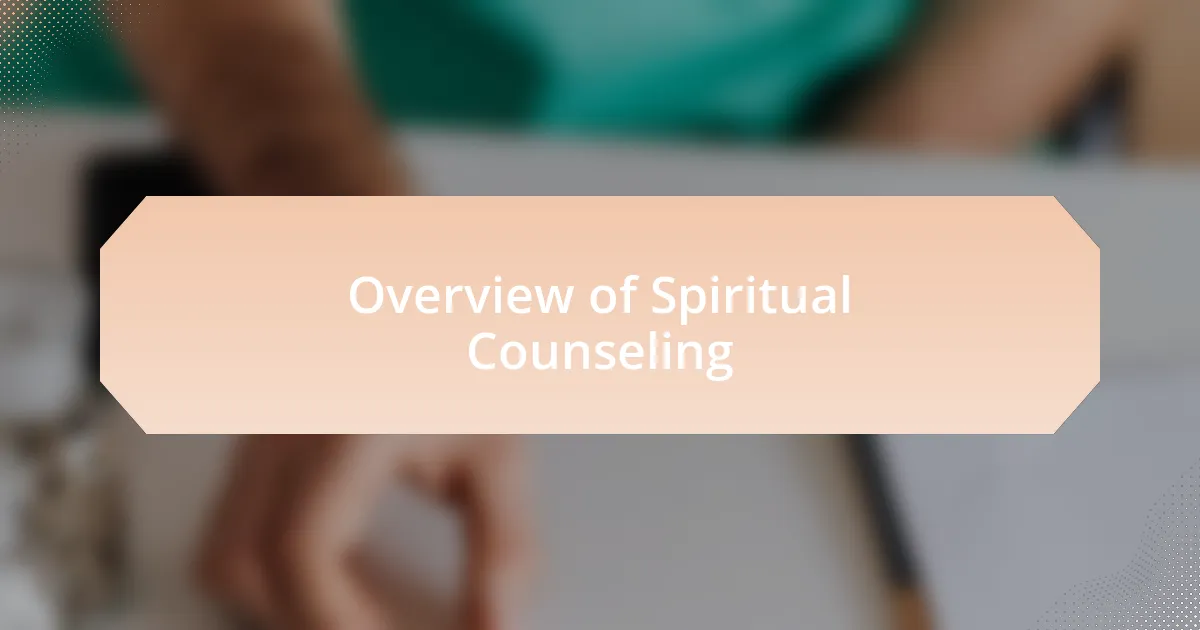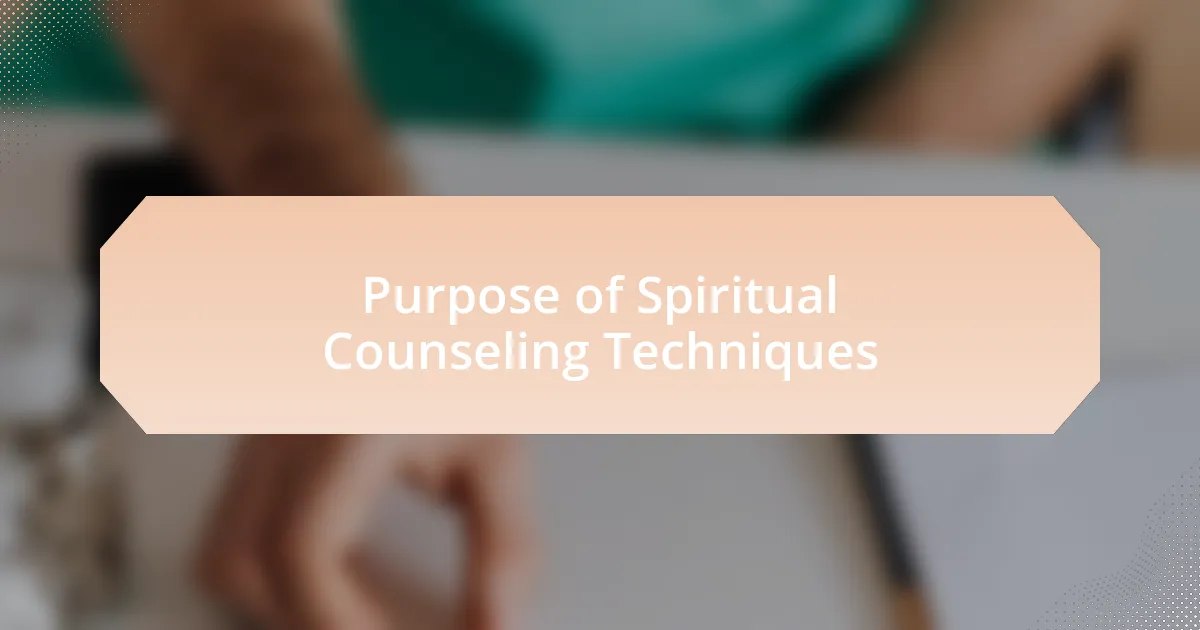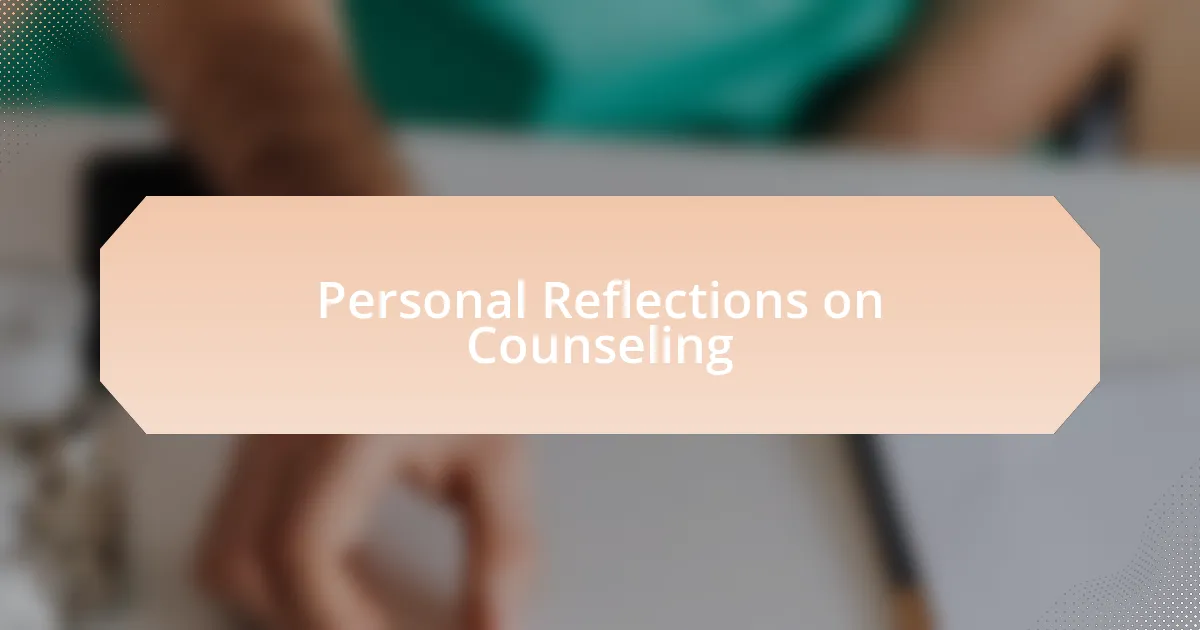Key takeaways:
- Hospital ministry provides essential spiritual support, bridging the gap between faith and healthcare, enhancing patient healing through understanding personal narratives.
- Spiritual counseling focuses on holistic care, integrating emotional, psychological, and spiritual dimensions, using techniques like guided imagery and mindfulness to facilitate personal growth.
- Effective counseling relies on active listening and empathetic engagement, allowing clients to explore their feelings freely, leading to transformative moments of self-discovery.

Understanding Hospital Ministry
Hospital ministry is a unique and vital aspect of healthcare that focuses on providing spiritual support to patients, families, and staff. I remember a time when I witnessed a chaplain comforting a grieving family in the waiting room. It struck me how a few kind words and a listening ear can bring immense comfort in their deepest moments of sorrow. Isn’t it remarkable how spiritual care often fills the gaps that clinical treatment cannot reach?
As I reflect on my experiences within hospital ministry, I realize it goes beyond merely praying for the sick or offering blessings; it involves truly understanding the fears and struggles people face in a clinical setting. Each patient’s journey is steeped in personal narratives that affect their healing process. How often do we pause and really listen to these stories, knowing that in their vulnerability lies the potential for profound connection and healing?
Moreover, hospital ministry serves as a bridge between faith and healthcare, inviting diverse beliefs into the healing conversation. I often find myself pondering – how can we integrate spiritual practices into patient care without intruding on individual beliefs? Engaging with these questions not only enriches the spiritual care provided but also deepens our understanding of how intertwined faith, hope, and healing truly are in the hospital environment.

Overview of Spiritual Counseling
Spiritual counseling is often about listening—truly listening. During my time in hospital ministry, I encountered a patient who was wrestling with her faith while facing a terminal diagnosis. It was in that intimate space where I saw how a few gentle questions could invite her to unveil her fears and doubts, thus forging a connection that transcended mere words. Don’t we all crave spaces where our inner turmoil can be shared without judgment?
At its core, spiritual counseling aims to address the whole person, integrating emotional, psychological, and spiritual dimensions into the healing process. I recall a moment when a nurse and I collaborated to provide comfort to a family experiencing anticipatory grief. By addressing not only their emotional needs but also their spiritual questions, we could create an atmosphere of peace amidst uncertainty. How often do we consider that a holistic approach can enhance not just individual well-being but also strengthen family bonds?
Furthermore, the techniques used in spiritual counseling can vary widely, from guided imagery to prayer and meditation. I once facilitated a small group where participants were encouraged to explore their feelings through journaling. Surprisingly, that simple exercise allowed individuals to articulate pain in ways they hadn’t before, revealing insights that sparked deeper healing conversations. Isn’t it fascinating how the act of putting pen to paper can unlock emotions that often remain bottled up?

Purpose of Spiritual Counseling Techniques
Spiritual counseling techniques serve a vital purpose in bridging the gap between physical experience and spiritual understanding. I recall a particularly moving session with a patient who struggled with feelings of abandonment. By using simple techniques like reflective listening, I was able to help her articulate her fears in a safe space. Isn’t it remarkable how sometimes just being heard can lead to profound revelations about ourselves?
One of the primary aims of these techniques is to foster a deeper self-awareness and connection with one’s inner self. I once guided a young man through a visualization exercise that invited him to envision his aspirations amidst his pain. As he described what he saw, it became apparent that his goals and fears were interwoven in ways he hadn’t previously recognized, highlighting the importance of these techniques in facilitating personal growth. How often do we overlook the potential for healing by simply engaging our imaginations?
Moreover, the emotional healing that often emerges from spiritual counseling can be transformative. I remember working with a couple who were grappling with their faith after losing a child. Utilizing prayer and collective reflection allowed them to confront their shared grief and ultimately find solace in their relationship. Have you ever considered how communal experiences can amplify healing, especially during life’s most challenging moments?

Common Spiritual Counseling Techniques
One commonly used spiritual counseling technique is guided imagery, where clients are invited to create vivid mental images that represent their struggles or desires. I once led a session where a woman visualized a garden that symbolized her life. As she described the weeds overtaking her flowers, it became clear that she was overwhelmed by her responsibilities. Isn’t it fascinating how our minds can illustrate what our hearts are feeling?
Another effective approach is the practice of mindfulness meditation, which encourages individuals to be present and aware of their thoughts and feelings without judgment. I’ve seen incredible transformations when clients engage in this technique. During a group session, someone shared that focusing on their breath helped them let go of anxieties tied to past regrets. Have you noticed how simply being present can shift our perspective and provide a sense of peace?
Lastly, integrating scripture or spiritual texts into counseling can also serve as a profound tool for reflection and discussion. I remember a poignant moment when a patient drew strength from a particular passage that resonated with their struggles. It sparked a heartfelt conversation about faith and personal interpretation that deepened their understanding. How often do we find comfort in words that seem to speak directly to our situation?

Personal Reflections on Counseling
Counseling, to me, has always been a nuanced dance between listening and sharing. I recall a time when a patient shared their overwhelming grief over a lost loved one. As they spoke, I felt the weight of their sorrow, and it allowed me to connect on a deeper level. How often do we find that vulnerability in others can open the door to healing for both the speaker and the listener?
There are moments during a session when I ask open-ended questions, which often lead to unexpected breakthroughs. One specific instance comes to mind when a client reflected on their feelings of abandonment, sparked by a simple question about their childhood memories. Watching that realization unfold felt like witnessing a spring thaw, where emotions once buried started to flow freely. Isn’t it remarkable how the right question at the right time can lead to profound insights?
I’ve learned that empathy is the cornerstone of effective counseling. I once supported a young man struggling with anxiety, and our discussions about his fears revealed not just the roots of his anxiety but also his strengths. It made me appreciate how even in our darkest moments, we possess resilience waiting to be uncovered. Can we really underestimate the power of understanding someone’s story?

Implementing Techniques in Practice
Implementing spiritual counseling techniques in practice feels like navigating a river — sometimes calm, sometimes turbulent. I remember introducing mindfulness exercises in a session with a woman grappling with stress from her caregiving responsibilities. One simple guided breathing technique helped her find an oasis of calm amid her chaotic thoughts, allowing her to step back and gain clarity on her situation. Isn’t it fascinating how a moment of stillness can shift our entire perspective?
Active listening is a powerful tool I often utilize. In one memorable session, a man spoke about his struggles with forgiveness. Instead of jumping in with advice, I simply mirrored back what he expressed. When he heard his own words reflected, it sparked a deeper exploration of his feelings. Have you ever noticed that sometimes the most profound insights come not from advice, but from truly being heard?
I often intertwine visualizations into my counseling practice, encouraging clients to envision their path to peace. For instance, during a session with a woman facing chronic pain, I guided her to visualize a warm light encompassing her. As she spoke, I could see her relax, almost as if she were physically shedding some of her burdens. How can something as simple as a mental image enable someone to tap into their inner strength and resilience?